By Doug Jardine
Here is a summary of the most prevalent diseases in corn, soybeans, and grain sorghum in Kansas during the 2018 growing season.
Corn Diseases
Early- to mid-season drought followed by heavy rainfall in August and early September led to an interesting complex of problems for the 2018 Kansas corn crop. In many parts of the eastern half of the state, drought was so severe that fields failed to set ears. For those that did, Aspergillus ear rot infection was common (Figure 1), with incidence levels ranging from zero to over 80% in one Miami County field. Many aflatoxin tests were above the 20-ppm level considered safe for human consumption, but well below the maximum usage rate of 300 ppm. A Kansas State University veterinarian indicated there was some aflatoxicosis reported in Kansas livestock. Late-season rains allowed for the development of Fusarium ear rot, which produces the mycotoxin, fumonisin. While levels were generally below those considered safe for cattle, veterinarians reported some fumonisin-related deaths in horses and hogs.
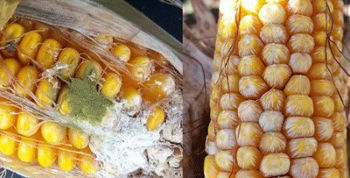
Figure 1. Aspergillus ear rot has a characteristic yellow-green color (left) and Fusarium ear rot often has a distinctive starburst pattern (right). Photo provided by Doug Jardine, K-State Research and Extension.
Gray leaf spot levels in 2018 were generally below treatable levels at tasseling, when fungicide decisions needed to be made, but increased rapidly in late-season when cloudy weather with frequent heavy rains occurred. Overall, losses were near the long-term average.
Eight new counties were added to the list of counties confirmed to have bacterial leaf streak, bringing the state’s total to 46 (Figure 2). A few cases of Goss’s bacterial blight and Diplodia ear rot were also reported from western Kansas. On a positive note, southern rust incidence and severity were significantly less than in the past two years.
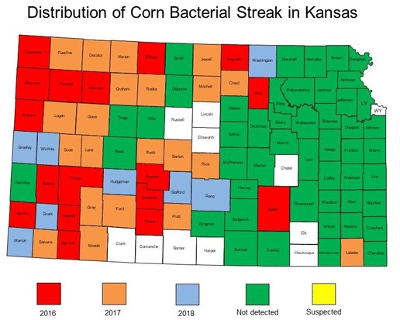
Figure 2. Current distribution of corn bacterial streak in Kansas by year. Counties in white have not been surveyed yet.
Stalk rot losses were above-average in 2018. Fusarium stalk rot was by far the predominant disease found in grower fields, but charcoal rot and anthracnose stalk rot were all reported in various reporting districts, especially in the eastern half of the state where weather patterns were most favorable for stalk rot development (Figure 3).
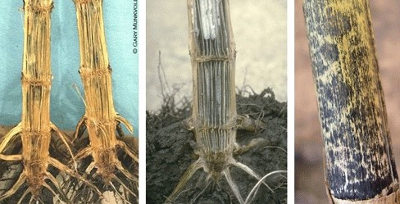
Figure 3. Fusarium stalk rot (left), charcoal rot (middle), and anthracnose stalk rot (right). Photo credits Gary Munkvold, Iowa State University (left), Doug Jardine, K-State (middle), Pioneer Seeds (right).
Soybean diseases
The mid-season drought made conditions favorable for charcoal rot, but late-season rains allowed the avoidance of that problem but created several more. Heavy August rains caused the development of late-season Phytophthora root rot problems, which resulted in premature death in many fields (Figure 4). This premature death likely reduced yields by 10 percent or more in affected fields (Figure 5).
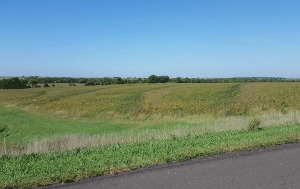
Figure 4. A north central Kansas soybean field where drier terrace tops remained healthy while areas between terraces died prematurely from Phytophthora root rot. Photo by Doug Jardine, K-State Research and Extension.
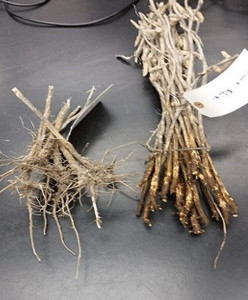
Figure 5. Phytophthora infected roots (right) from a center pivot irrigated field in north central Kansas and healthy roots (left) from the non-irrigated corner of the same field. Photo by Doug Jardine, K-State Research and Extension.
The late-season rains also brought on sudden death syndrome symptoms, but because of the lateness and the adoption of ILeVO seed treatment, losses were below long-term averages. Frogeye leaf spot developed in September and later-planted fields of susceptible varieties that were not treated with a fungicide likely suffered yield losses (Figure 6).
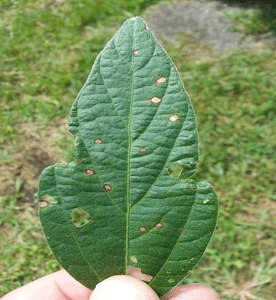
Figure 6. Frogeye leafspot lesions. Photo by Doug Jardine, K-State Research and Extension.
The most serious problem in the 2018 Kansas soybean crop developed late in the year. August and October rains allowed the development of several late-season stem and pod diseases, including pod and stem blight, purple seed stain, and anthracnose (Figure 7). Because these diseases reduce seed quality, many loads of soybeans were docked heavily at elevators or simply refused.
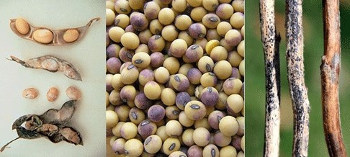
Figure 7. Pod and stem blight (left), purple seed stain (middle), and anthracnose (right) are late-season diseases that reduce yield and quality. Photos by J.B. Sinclair, University of Illinois (left); Doug Jardine, K-State (middle); Darren Mueller, Iowa State University.
Sorghum Diseases
The 2018 Kansas sorghum crop was healthier than any in recent memory. Sooty stripe levels were high in a few south-central Kansas fields, but generally less than in the past two years (Figure 8).
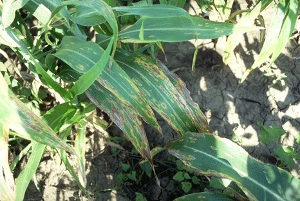
Figure 8. Sooty stripe developing in the lower canopy of grain sorghum. Photo by Doug Jardine, K-State Research and Extension.
Late-season rains caused an increase in head molds, but overall, incidence was relatively low. Like corn, the most significant sorghum disease in 2018 was Fusarium stalk rot. Reports of late-season lodging were few, however.
Source: ksu.edu